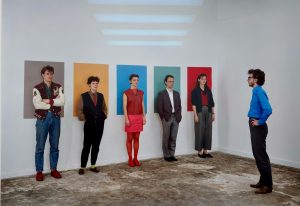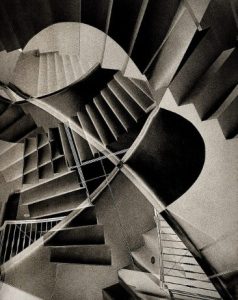Please scroll down for English
תמר הרפז – Kitchen Sink Drama
תמר הרפז היא אמנית מצוינת שדווקא, Kitchen Sink Drama המיצב הגדול ביותר שלה עד היום, טוב פחות ממה שהציגה בעבר.

הרפז בולטת מ 2009 אז הציגה בתערוכת בוגרי התואר השני בבצלאל מיצב אינטליגנטי בו יצרה עם עדשות דימוי מכני לליקוי חמה ולצידו עשתה שימוש במקרני שקופיות שבאחד הפוקוס נע בין דמויות מסצנה בסרט “היו זמנים במערב” של סרג’יו ליאונה (1968 ) והשני ניסה להתמקד שוב ושוב מבעד לזכוכית סדוקה. מאז סיום לימודיה הציגה באינטנסיביות וזכתה בשורת פרסים בהם פרס גיבעון של מוזיאון תל-אביב ב2010 ו פרס אנסלם קיפר של קרן וולף 2013.
בתערוכה המשובחת WYSIWYG: What You See Is What You Get שאצרה ענת דנון–סיון במוזיאון תל אביב לפני שנה הציגה הרפז עבודה פיוטית מורכבת בשם Pear in a Bottle (טכניקה צרפתית בה מגדלים ניצן אגס בבקבוק המחובר לעץ ומכבים אח”כ במשקה אלכוהולי בדרך כלל ברנדי) . היה זה מערך של מראות קעורות ואובייקטים שיצרו רשת מורכבת של שבירות והתחברויות אופטיות מקסימות אך גם מרתיעות . הרפז, בעזרת יופי רב, סדקה קלות את קליפת השלווה של מה שנדמים לנו כחוקי הפיזיקה המכתיבים את פעולת העולם.
ב- Kitchen Sink Drama הקסם לא עובד. הדרמה ברורה מידי – חלב שפוך וכיור שנפל, כיריים מפורקים, כסא הפוך וקמח מפוזר – כל מה

שצריך בחלל ביתי שהפך לזירת קרב .
Kitchen Sink Drama הוא כאן ועכשיו, דיון על אלימות ופמיניזם. העשייה של הרפז שנעה עבר בין משחקי אופטיקה, ומהצילום ועד הקולנוע (ואפשר לחשוב על קאמרה אובסקורה ) תוך נגיעה בחבל הדק שבין קסם לגוון של חיפוש רוחני, הצטמצמה הפעם לתרגיל מרשים למדי.בקומת הכניסה עומדים הצופים מול סצנת המטבח המפורק. למעט פרטים בודדים כמו אננס מחובר לצנרת כיור מפורק ,מחווה מחויך לסוריאליזם, הסצנה נדמת מיד מוכרת מסדרות בלשים וסרטי מתח. היא מוארת כסט קולנועי בתאורה נמוכה וממוקדת ועמודי תאורה גבוהים כך שנוצרת תחושה חזקה של פירוק ותזזית. הדימויים מתאחדים במראות ועדשות אותם רואים כשעולם למרפסת הנמצאת בקומה השנייה

ומשקיפה לאולם התחתון.
הרפז משתמשת, בוודאי באופן מודע ,בדימויים שנשענים על עבודה קאנונית כמו הווידיאו Semiotics of the Kitchen החשוב והמצוטט תדיר של מרתה רוסלר האמריקאית מ 1975. רוסלר יצרה פרודיה על תוכנית בישול בה המנחה עוברת אסקלציה רגשית והמטבח הופך לסיוט כאוטי. פרוק המטבח הופך לניפוץ מטפורי של שורת התפקידים, והמגבלות בהן נאלצו נשים לפעול .

יש בעבודה של הרפז גם מידה של התייחסות ל WS (ראשי התיבות של שלגייה הכתובים בסיכול אותיות) וידיאו מונומנטאלי של פול מקארתי מ 2013 שהוצג בארמורי בניו יורק ובו הוא חזר ויצר, כמו ברבות מעבודותיו הקודמות,סצנות של סביאה והרס במטבח . ההקשר נוסף של העבודה הוא לעבודות של Michael Elmgreen מדנמרק ו Ingar Dragset מנורבגיה הפועלים כצמד מברלין . הם עוסקים ביחסי אדריכלות אמנות ויוצרים מייצבים שאפשר להגדיר כאתרי שיבוש .ב 2009 יצגו את נורבגיה ודנמרק בעבודות ענק בשם האספנים וב 2013 הציגו בויקטוריה ואלברט בלונדון את מחר מיצב של ביתו של אדריכל . האלימות בעבודות נעה ביו גלויה כמו “גופת” האספן שצפה בברכה או חדר ובו סימני דם בביאנאלה וונציה למרומזת במיצב בלונדון. העבודה של הרפז לוחצת על כל הכפתורים-

המטבח , טריטוריה שעדיין מתקשרת בעיקר לנשי מוצגת בכאוס כלאחר התרחשות אלימה. החיבור- איחוי – הבנה של הסצנה נעשית באמצעות העדשות והמראות כלומר היא תלויה בעמידה של הצופה בנקודה מסוימת , מטאפורה מצוינת לכך המציאות היא מציאויות רבות המוכתבות מזווית ההתבוננות. חסרה בעבודה המסתורין והאמביוולנטיות שהפכו את העבודות הקודמות של הרפז להרבה יותר מקסם, יופי ומסתורין. בתערוכה . Girl to Gorilla, בגלריה זומר (שם לקוח ממופע בירידים אמריקאים בהם אישה הופכת בתהליך מהיר מיפיפייה לגורילה) הייתה מיטה שמזווית מסוימת נראתה ריקה ולידה כסא וקופסת טישו, (מיטה לפסיכואנליזה?) ומזווית אחרת, נראה על המיטה מוט ברזל, פוטנציאל או זיכרון אלימות. Kitchen Sink Drama הווליום של האלימות, של החד משמעיות, הוגבר ומשתיק את הקורים המעודנים, והמעניינים, יותר.
צדוק הכהן 2א’ (ליד קלישר 5) ת”א
שעות פתיחה: שני – חמישי 14:00-19:00 | שישי – שבת 10:00-14:00
הערה על ארוגים בתודעה – טקסטיל עכשווי בישראל
אופן התקבלות התערוכה ארוגים בתודעה שנסגרה במוזיאון ארץ ישראל הוא סיפור התחום בו היא עוסקת: תערוכה עם 59 משתתפים שעברה כמעט ללא התייחסות של כלי התקשורת המסורתיים. טקסטיל נתפס עדיין כשולי.
התערוכה המענינת הזו נגעה בשאלות אופן מבע ומיון מדיומלי ,אתגרה את ההפרדה הרעועה של מעצבים/אמנים והכילה התבוננות על מסורת המודרניזם הישראלי. החתך כלל אמנים מזרם המרכזי שעובדים תדיר בטקסטיל: אלה אמיתי סדובסקי, גילי אבישר ואסתר שניידר, לצד אמנים שהטקסטיל משמש אותם בעבודות ספציפיות בהן טלי נבון, עינת אמיר או טובה

לוטן
אוצרת אירנה גורדון
סיור לביתו של ניסיםכחלון בחוף סידני עלי בהרצליה . מדובר בבית שמהווה יצירה ובחוויה מיוחדת מאד. פרטים בעמודת הסיורים .
הרשמה לניוזלטר הפירסומי השבועי של “החלון” בנושאי אמנות, אירועים ותערוכות חדשות – https://www.smadarsheffi.com/?p=925
(הרישום נפרד מהרישום לבלוג )
Tamar Harpaz: Kitchen Sink Drama
Tamar Harpaz is an excellent artist, however, her current installation Kitchen Sink Drama, her largest to date, now on exhibition at the Center for Contemporary Art, Tel Aviv, is of lesser quality than what she has shown in the past.

(detail)
Harpaz has been an artist to watch since the Bezalel MFA exhibition in 2009. She exhibited an intelligent installation which used mechanical image of a solar eclipse alongside of a slide projector whose focus moved between two figures in one slide of a scene from Sergio Leone’s 1968 film, Once Upon a Time in the West, while the second tried to focus behind a cracked lens. Since graduation, Harpaz has an impressive record with a long list of prizes, including the Givon Prize from the Tel Aviv Museum of Art in 2010 and the Anselm Kiefer Prize from the Wolf Foundation in 2013. Last year’s notable exhibition at the Tel Aviv Museum of Art, WYSIWYG: What You See Is What You Get, curated by Anat Danon-Sivan, included a poetic, complex work by Harpaz, Pear in a Bottle, based on a French technique of growing a pear bud inside a bottle connected to the tree, later used to make an alcoholic drink, usually brandy. A network of curved mirrors and objects created a complex chain of charming yet frightening optical breakages and connections. Harpaz, using elements of great beauty, has slightly cracked the calm surface of what seem to be the laws of physics dictating how the world works.

(detail)
The magic is not working in Kitchen Sink Drama: the drama is explicit – spilt milk and a fallen sink, a dismantled burner, an overturned chair and flour powdering the floor – evidence of a domestic space turned into battle zone. Kitchen Sink Drama is here and now, a discussion of violence and feminism. Harpaz’s past works, moving between optics, still photography and cinema (including camera obscura), touch upon places in which art takes on a shade of a spiritual quest and have here been reduced to a very impressive exercise.
On the entrance level, viewers encounter the scene of the dismantled kitchen. Except for very few details such as a pineapple connected to the fallen sink piping, an amusing homage to Surrealism, the scene seems immediately familiar from film noir and detective series. The lighting looks like a film set, low focused lighting and high light stands create a strong feeling of deconstruction and movement. The images come together in mirrors and lenses visible when walking up to the balcony on the second floor, overlooking the lower hall.

(detail)
Harpaz most probably consciously uses images based on canonical works such as the important video art Semiotics of the Kitchen (1975), by American artist Martha Rosler, which has been frequently quoted. Rosler created a parody of cooking programs in which the presenter’s emotions escalate, turning the program into a chaotic nightmare. The deconstruction of the kitchen becomes a metaphorical explosion of roles, assumptions and limitations which coerced women’s actions.
Harpaz’s installation has, to some extent, references to WS (the initials of “Snow White” in reverse), a monumental video by Paul McCarthy from 2013, exhibited at the New York Armory Show, in which he created scenes of riotous drunkenness and destruction in a kitchen.

Photo: Joshua White
An additional context for the work is the duo of Michael Elmgreen (Denmark) and Ingar Dragset (Norway), working in Berlin. They engage in the relations between architecture and art, making installations which may be described as sites of disruption. The two represented Norway and Denmark at the 2009 Venice Bienniale with their installation The Collector, and in 2013, Tomorrow was installed at the Victoria and Albert Museum, London, depicting an architect’s home. The violence in the works shift between the overt, such as the “corpse” of the collector floating in a pool, or a room with bloodstains in the Venice Biennale, to the covert violence in Tomorrow.
Harpaz has pulled out all the stops: the kitchen, a territory mainly associated with the feminine, is featured in chaos following a violent event. The disruption and connection, the understanding of the scene, is accomplished through lenses and mirrors; this means it depends on the viewer standing at a specific point. This is an excellent metaphor for multiple realities, depending on one’s viewpoint.
The work lacks the mystery and ambivalence which transformed her earlier works to something more than charming. In Girl to Gorilla (the name taken from a sideshow in American fairs in which a beautiful woman turns into a gorilla), her exhibition at the Sommer Contemporary Art, Tel Aviv, there was, for example, a bed which from a certain angle seemed empty, with a chair and box of tissues near it (a couch for psychoanalysis?) and from a different angle it seemed to have an iron bar on it, the potential or the memory of violence. In Kitchen Sink Drama, the “volume” of the violence, the clarity, has been turned up, and silences the more delicate and more interesting strands.

(detail)
CCA The Center for Contemporary Art, 2 Tsadok HaCohen, Tel Aviv-Yafo, Israel, Mon.-Thurs. 2-7 p.m., Fri.-Sat., 10 am-2 pm
Comment about Woven Consciousness: Contemporary Textile in Israel.
The reception the traditional media gave this exhibition at the Eretz Israel Museum (exhibition closing this week) reflects the field: despite the 59 participants, “Woven Consciousness” received little treatment by any of the media, as textile art and design is still perceived as marginal in Israel.This interesting exhibition touched on issues of the way this medium is expressed and classified, challenged the shaky separation of designers

from artists, and examined the tradition of Israeli Modernism.The cross-section of participants included mainstream artists who frequently work with textiles, such as Ella Amitay Sadovsky, Gili Avissar and Esther Schneider, along with visual artists who use textiles in specific works, such as Tali Navon, Einat Amir or Tova Lotan.
Curator: Irena Gordon
A tour of Nissim Kahalon’s house on the Sidni Ali beach in Herzliya. This is a house which is a work of art in itself, and the visit a unique experience. Please see getails in the Art Tour column.
To sign up (separately) for the Window’s weekly informational advertising newsletter on art, special events, and openings: https://www.smadarsheffi.com/?p=925





